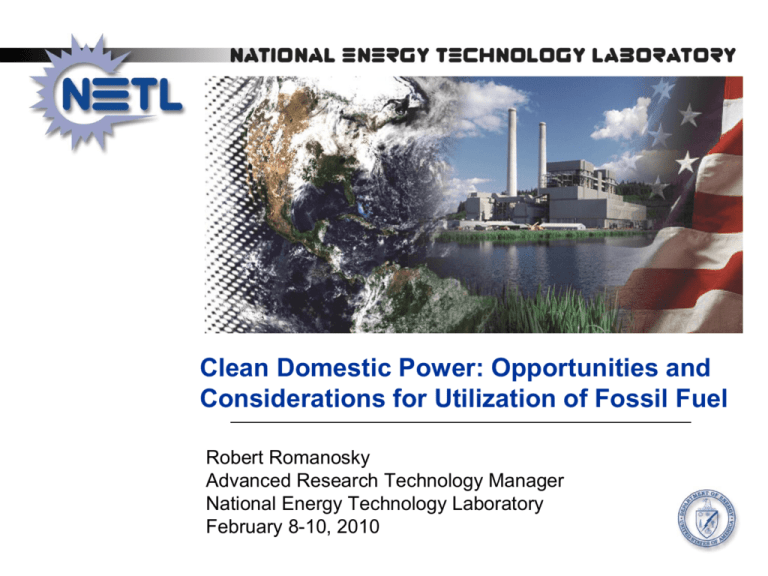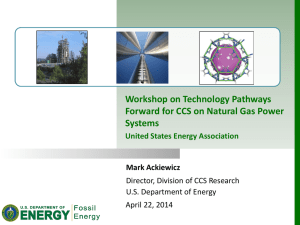Clean Domestic Power: Opportunities and Considerations
advertisement

Clean Domestic Power: Opportunities and Considerations for Utilization of Fossil Fuel Robert Romanosky Advanced Research Technology Manager National Energy Technology Laboratory February 8-10, 2010 Energy Contributes to Quality of Life GDP vs. Energy Consumption 100,000 GDP per Capita (US$ / person / yr) UK Qatar U.S. Bahrain Mexico 10,000 South Africa Peru Congo Bulgaria 1,000 China Eritrea India 100 100 1,000 10,000 100,000 Annual Energy Consumption per Capita (kgoe / person / yr) Development Data Group, The World Bank. 2008; Population Division of the Department of Economic and Social Affairs of the United Nations Secretariat: IEA Statistics Division ‹#› Energy Demand 2006 Energy Demand 2030 111 QBtu / Year 78% Fossil Energy 100 QBtu / Year 85% Fossil Energy Coal Gas 23% 22% Oil 41% + 11% Nuclear 8% Renewables 6% United States Oil 34% Nuclear 8% Oil 34% 675 QBtu / Year 81% Fossil Energy + 45% Nuclear 6% Gas 22% Renewables 13% 465 QBtu / Year 81% Fossil Energy Coal Gas 26% 21% Coal 23% World Renewables 13% Coal 29% Gas 22% Oil 30% Fossil Energy Continues to Dominate Supply U.S. data from EIA, Annual Energy Outlook 2009, ARRA release ; world data from IEA, World Energy Outlook 2008 ‹#› Nuclear 5% Renewables 14% Challenge and Program Driver: Annual CO2 Emissions Extremely Large Emissions Total Release in the U.S., short tons per year Mercury Sulfur Dioxide (SO2) Municipal Solid Waste Carbon Dioxide (CO2) 120 15,000,000 230,000,000 6,300,000,000 1 million metric tons of CO2: • Every year would fill a volume of 32 million cubic feet • Close to the volume of the Empire State Building Data sources: Mercury - EPA National Emissions Inventory (1999 data); SO2 - EPA air trends (2002 data); MSW - EPA OSWER fact sheet (2001 data); CO2 - EIA AEO 2004 (2002 data) ‹#› Technological Carbon Management Options Pathways for Reducing GHGs -CO2 Improve Efficiency Reduce Carbon Intensity • Renewables • Nuclear • Fuel Switching • Demand Side • Supply Side All options needed to: Affordably meet energy demand Address environmental objectives ‹#› Sequester Carbon • Enhance Natural Sinks • Capture & Store DOE Fossil Energy Coal RD&D Platform Goals Programs RESEARCH & DEVELOPMENT Core Coal and Power Systems R&D DOE – FE – NETL TECHNOLOGIES & BEST PRACTICES < 10% increase COE with CCS (pre-combustion) < 35% TECHNOLOGY DEMONSTRATION Clean Coal Power Initiative Stimulus Activities DOE – FE – NETL increase COE with CCS (post- and oxy-combustion) < $400/kW fuel cell systems (2002 $) > 50% plant efficiency, up to 60% with fuel cells FINANCIAL INCENTIVES ‹#› > 90% CO2 capture Tax Credits Loan Guarantees > 99% CO2 storage permanence DOE – LGO – IRS +/- 30% storage capacity resolution Approaches • Post Combustion CO2 Capture • Oxy-Fired Combustion • Chemical Looping • UltraSupercritical Combustion • Materials & Modeling • Process Integration & Control • Demonstration & Deployment Programs Coal Based Power A Portfolio of Alternate Paths Fuel Cell Membranes PETROCHEMICAL PLANT GASIFICATION CO2 Capture Fuels water shift selexol O2 CO2 Capture IGCC water shift selexol Air HYBRID COMBUSTION GASIFICATION AIR BLOWN IGCC CO2 Capture Chemical O2 CHEMICAL LOOPING IGCC & Carbonate looping CO2 Capture Carbonate looping CFB COMBUSTION USC CFB O2 Air ADVANCED CFB CO2 Capture O2 Oxygen Fired CFB or PC CO2 Capture MEA PC ‹#› USC PC CO2 Capture Fossil Energy CO2 Capture Solutions Post-combustion (existing, new PC) Pre-combustion (IGCC) Chemical looping Cost Reduction Benefit Oxycombustion (new PC) OTM boiler CO2 compression (all) Amine solvents Physical solvents Cryogenic oxygen Advanced physical solvents Advanced chemical solvents Ammonia CO2 compression PBI membranes Solid sorbents Membrane systems ITMs Biomass cofiring Ionic liquids Metal organic frameworks Enzymatic membranes CO2 Capture Targets: • 90% CO2 Capture • <10% increase in COE (IGCC) • <35% increase in COE (PC) 2010 2015 Time to Commercialization OTM – O2 Transport Membrane (PC) ITM – O2 Ion Transport Membrane (PC or IGCC) ‹#› Biological processes 2020 Advanced PC Oxy-combustion Challenges • Cryogenic ASUs are capital and energy intensive Ultra-supercritical Oxyboilers Air-Fired Water-wall tube heat transfer Division Walls Fireside • Excess O2 and inerts (N2, Ar) h CO2 purification cost • Existing boiler air infiltration O OFA Ports Burners Waterwalls Wall side • Corrosion and process control Advanced Oxy-combustion R&D Focus • New oxyfuel boilers - Advanced materials and burners - Corrosion • Low-cost oxygen O2 Membranes • Retrofit existing air boilers - Air leakage, heat transfer, corrosion - Process control • CO2 purification • Co-capture (CO2 + SOx, NOx, O2) Boiler size reduced by >30% Heat Flux (Btu/hr-ft2) Oxygen Membranes 1000oC, 1832 F PO' Flux ln '' 2 PO2 CO2, H2O eO2 + 4e- → 2O2O2- ~ 500 psig CH4, CO, H2 Air 3-5 psig Current Scale: Computational modeling through 5 MWe Pilot-scale Partners (11 projects): Praxair, Air Products, Jupiter, Alstom, B&W, Foster Wheeler, REI, SRI ‹#› Chemical Looping Combustion Chemical Looping Advantages: • Oxy-combustion without an O2 plant Key Challenges • Potential lowest cost option for near-zero emission coal power plant <20% COE penalty • Solids transport • Heat Integration • New and existing PC power plant designs Air Reactor (Oxidizer) CaS + 2O2 CaSO4 + Heat Oxy-Firing without Oxygen Plant Steam Air Ox 2000F MB HX N2 + O2 CaSO4 CaS 1700F Solid Oxygen Carrier circulates between Oxidizer and Reducer Oxygen Carrier: Carries Oxygen, Heat and Fuel Energy Carrier picks up O2 in the Oxidizer, leaves N2 behind Carrier Burns the Fuel in the Reducer Heat produces Steam for Power Status Red Fuel CO2 + H2O Fuel Reactor (Reducer) CaSO4 + 2C + Heat 2CO2 + CaS CaSO4 + 4H2 + Heat 4H2O + CaS 2010 Alstom Pilot test (1 MWe) 1000 lb/hr coal flow 1st Integrated operation 1st Autothermal Operation Key Partners (2 projects): Alstom Power (Limestone Based), Ohio State (Metal Oxide) ‹#› UltraSupercritical Boilers and Turbines Current technology for USC Boilers – Typical subcritical = 540 °C – Typical supercritical = 593 °C – Most advanced supercritical = ~610 °C • USC Plant efficiency is improved to 45 to 47% HHV • Ultrasupercritical (USC) DOE goal for higher efficiency and much lower emissions, materials capable of: – 760 °C (1400 °F) – 5,000 psi – Oxygen firing • Meeting these targets requires: – The use of new materials – Novel uses of existing materials 48 Plant Thermal Efficiency (%) • 5500 psi 46 3500 psi 44 42 Birks and Ruth 40 900 1000 1100 1200 1300 Temperature (°F) ‹#› 1400 1500 1600 Benefit of Higher Efficiency in Reducing CO2 2 Percentage Point Efficiency Gain = 5% CO2 Reduction 20% reduction in CO2 corresponds with similar reductions (per MWh) in consumables including coal and limestone (reducing front-end equipment size), flue gas volume (reducing back-end and emission control equipment size), and overall emissions, water use, and waste generation (Bituminous coal, without CO2 capture) ‹#› Efficiency Contribution from Sensors and Controls Value Derived for an Existing Coal Fired Power Plant 1% HEAT RATE improvement 500 MW net capacity unit • $700,000/yr coal cost savings • 1% reduction in gaseous and solid emissions Entire coal-fired fleet • $300 million/yr coal cost savings • Reduction of 14.5 million metric tons CO2 per year Gaseous Emissions 500 MW 10,200 Btu/kWh POWER 3.5 billion kWh/yr @ 80% capacity factor COAL 35,700 MMBtu/yr $70 million/yr @$2/MMBtu Solid Waste 1% increase in AVAILABILITY Analysis based on 2008 coal costs 500 MW net capacity unit and 2008 coal-fired power plant fleet (units greater than 300 MW) • 35 million kWh/yr added generation • Approximately $2 million/yr in sales (@ 6 cents/kWh) Entire coal-fired fleet • More than 2 GW of additional power from existing fleet ‹#› Carbon Sequestration Program Goals • Deliver technologies & best practices that provide Carbon Capture and Safe Storage (CCSS) with: – 90% CO2 capture at source – 99% storage permanence – < 10% increase in COE • Pre-combustion capture (IGCC) – < 35% increase in COE • Post-combustion & Oxy-combustion Core R&D Pre-combustion Capture Global Collaborations Geologic Storage North America Energy Working Group Infrastructure Monitoring, Verification, and Accounting (MVA) Simulation and Risk Assessment Carbon Sequestration Leadership Forum International Demonstration Projects Regional Carbon Sequestration Partnerships Characterization Validation CO2 Use/Reuse ‹#› Asia-Pacific Partnership (APP) Development National Atlas Highlights - 2008 U.S. Emissions ~ 6 Billion Tons CO2/yr all sources ~ 2 Billion Tons CO2/yr coal-fired power plants Saline Formations Oil and Gas Fields Conservative Resource Assessment North American CO2 Storage Potential (Billion Metric Tons) Sink Type Low High Saline Formations 3,300 12,600 Unmineable Coal Seams 160 180 Oil & Gas Fields 140 140 Unmineable Coal Seams Hundreds of Years Storage Potential Available for download at http://www.netl.doe.gov/publications/carbon_seq/refshelf.html ‹#› Demonstration & Deployment Programs Reduce risk and promote adoption of new technology at large scales • Clean Coal Power Initiative (CCPI) • Industrial Carbon Capture & Sequestration (ICCS) • FutureGen ‹#› PPII & CCPI Demonstration Project Locations for ICCS Projects Area 1 AwardedCarbon Capture and Storage fromShare Industrial Sources Locations & Cost In Negotiation Great River Energy Battelle, Boise White Paper Mill, Basalt, Complete Fluor Econamine Plus, Washington Excelsior Energy Lignite Fuel Enhancement $31.5M – Total $13.5M – DOE Basin Electric Postcombustion CO Capture Post Combustion CO2 Capture $668M – Total $334M – DOE NeuCo (Baldwin) Integrated Optimization Software $19M – Total $8.6M – DOE Summit TX Clean Energy Commercial Demo of Advanced IGCC w/ Full Carbon Capture ~$1.9B – Total $350M – DOE Cemex,; Cement; EOR & Saline, RTI Dry Carbonate Odessa, TX HECA Southern Company Services Post-combustion CO2 Capture $668M – Total $295M – DOE Selexol, Sweeny, TX NeuCo (Limestone) Mercury Specie & Multi-pollutant Control $15.6M – Total Praxair; H2 for Refinery; $6.1M – DOE ‹#› Archer Daniels Midland; Industrial Power & Ethanol; Saline, DOW Alstom Amine, Decatur, IL CONSOL Leucadia Energy; Greenidge Multi-pollutant Control SNG from petcoke; $32.7M – Total EOR, Rectisol, $14.3M – DOE Mississippi Emission Control Commercial Demo of Advanced IGCC w/ Full Carbon Capture Conoco Phillips; IGGC~$2.8B – Total Petcoke; Depleted NG/EOR, $308M – DOE EOR, VPSA, Texas City, TX TOXECON Multi-pollutant ProjectControl Location $53M – Total Industry Type / Product $24.9M – DOE Sequestration Type CO2 Capture AEP Technology Univ. of Utah; Ammonia & Cement; EOR & Saline, Dehydration, Coffeyville, KS 2 C6 (Shell); H$287M 2 – Total Production; Saline, $100M – DOE ADIP-X Amine, Solano, CA Wisconsin Electric Mesaba Wolverine, Energy Project CFB Power; $2.16B – Total EOR, Hitachi Amine, $36M –Rogers DOE City, MI Southern Company Leucadia Energy; Fuel Methanol; EOR, Rectisol,Advanced Power Lake Charles, LA Systems IGCC-Transport Gasifier Texas Energy; Petcoke $2B – Total Gasification (H2, MeOH & $294M Air Products, H2 – DOE Production; EOR, BASF’s aMDEA Port Arthur, TX; NH3); EOR, Rectisol, Beaumont, TX FutureGen Objectives • Establish technical, economic & environmental viability of “near- zero emission” coal-fueled plant by 2015 • Validate DOE goals – (ref. Report to Congress, dated March 2004): – Sequester >90% CO2 with potential for ~100% – >99% sulfur removal; <0.05 lb/MMBtu Nox; <0.005 lb/MMBtu PM; >90% Hg removal • Prototype 275 MWe coal-based power plant of the future sized to: – Utilize utility-scale (7FB) gas turbine – Adequately stress saline geologic formation • Integrate full-scale CCS operations • Serve as potential test facility for emerging technologies ‹#› FutureGen Potential “Proving Ground” for Emerging Technology Fuel Cells FutureGen Gasification with Cleanup Separation H2 Production ‹#› Optimized Turbines Carbon Sequestration System Integration Conclusions • The U.S. power generation industry is at a critical juncture – Demand, resources, workforce, reliability, regulation, grid integrity, transmission, etc. • Competing demands for reliable, low-cost energy and climate change mitigation appear incongruent • Uncertainty of regulatory outcomes and rising costs impact industry’s willingness to commit capital investment, endangering near-term production capacity • The U.S. must foster new processes that address conflicting energy objectives simultaneously • Our nation’s dependence on liquid fuel from foreign resources will continue to remain high for the near term ‹#› Contact Information Robert R. Romanosky 304-285-4721 Robert.romanosky@netl.doe.gov ‹#› NETL Office of Fossil Energy www.netl.doe.gov www.fe.doe.gov





